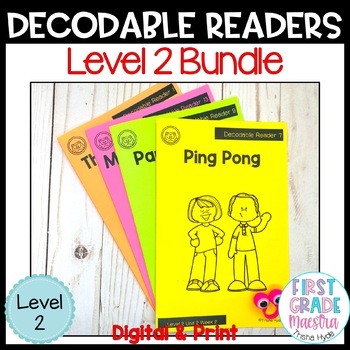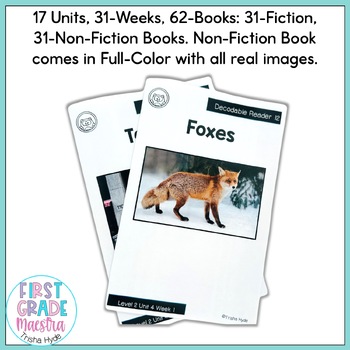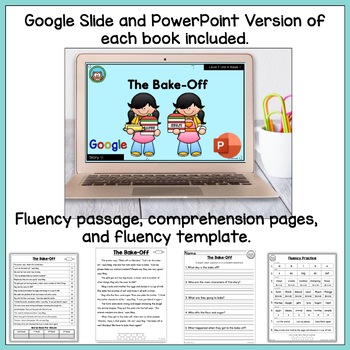Decodable Books and Resources |Fun Phonics Level 2 | Bundle
- Various file types
- Google Apps™

What educators are saying
Products in this Bundle (20)
showing 1-5 of 20 products
Description
Fun Phonics Decodable Readers for Level 2 Units 1-17. These Science of Reading decodable texts compliments Fundations ® and provide students the opportunity to practice the phonics skills they are learning in real time in their Fundations lessons. The texts also provide practice using previously taught skills. There are fewer pictures, so students have to rely on their decoding skills. In addition, students get to practice the Trick Words from the current lesson as well as Trick Words from previous lessons.
Each story is 6-pages of text. The books are formatted for 2-sided copies and use two sheets of paper per book. The length and complexity of each story increases as additional skills are introduced. These text are just the right length for small group instruction, whole group reading, homework, and independent reading.
These texts follow the Science of Reading (SoR) and align with the skills/words used throughout each lesson in Level 2 Unit 1-17. There are 31-Weeks of instruction for a total of 62 unique stories.
This bundle has 31- Fiction Text and 31-Non-Fictions Text.
Each Unit/Week of instruction includes:
Fiction text
Non-fiction text (with REAL images)
PowerPoint of Story with animated transitions
Google Slides of Story with animated transitions
Reading Fluency Passage page with word count
One Page Story
Comprehension Questions
Retell writing for Fiction story
Expository writing for Non-Fiction Story
Trick Word Cards
Story Word Cards
Decodable Word Cards
Decodable Word Cards with images
8-12 Word Work pages (The word work will change as students progress through the units.)
Answer Keys for All.
This Bundle Contains:
Unit 1: Review short vowels, digraphs, blends, closed syllables
Week 1: The New Boat, Chimps
Week 2: Cod and Crab, A Kilt
Unit 2: Review bonus letters, and glued sounds
Week 1: Shall We Go? A Boss
Week 2: Ping Pong, A Mink
Unit 3: Closed syllable exceptions
Week 1: Pan for Gold, A Colt
Unit 4: Suffix -s, -es, -ing, -er, -est, -ed (/id/, /d/, /t/)
Week 1: The Bake-Off, Foxes
Week 2: More Cookies?, Taxes
Unit 5: Multisyllabic words with suffixes -ness, -less, -ment, -ful, able, -ish, -en
Week 1: Is it a Hit?, Robins
Week 2: Let's Finish This!, One to Five
Unit 6: Vowel-consonant-e syllable, suffixes, /z/ between 2 vowels
Week 1: A Froze Pose, A 3-D World
Week 2: The Right Thing, Concrete
Unit 7: Open Syllables, Y as a vowel, Multisyllabic words, suffix -y, -ly, -ty
Week 1: Robot Fun, Motel or Hotel
Week 2: Find the Ring, Navy
Week 3: Mr. Ivy Smiles, Making Taffy
Unit 8: R-Controlled syllables with ar and or. Combining R-Controlled syllables with other syllable types.
Week 1: Rhyme Time, Garlic
Unit 9: R-Controlled syllables with er, ir, and ur. Combining R-Controlled syllables with other syllable types.
Week 1: Garnet, Surf's Up!
Week 2: The New Baby, Termites
Unit 10: Double Vowel Syllable Type, Sounds of ai and ay, combining all types of syllables, and homophones.
Week 1: The Gray Stray, Steam Trains
Week 2: Mermaid Party, Subway
Unit 11: Double Vowel Syllable Type, Sounds of ea, ee, and ey, combining all types of syllables, and homophones.
Week 1: A Jeep Trip, Queen Elizabeth ll
Week 2: I Can Do This!, Beavers
Unit 12: Double Vowel Syllable Type, Sounds of oi and oy, combining all types of syllables.
Week 1: Elroy, What is a Po'boy?
Unit 13: Double Vowel Syllable Type, Sounds of oa, oe, ow, combining all types of syllables.
Week 1: Snow Day, Setting a Goal
Week 2: Oh, No! My Arm!, Rainbows
Unit 14: Double Vowel Syllable Type, The /ou/ Sounds of ou, ow combining all types of syllables.
Week 1: Ouch! My Tooth!, Clouds
Week 2: Snow Problems, Clam Chowder
Unit 15: Double Vowel Syllable Type, The /u/ sound of oo, ou, ue, and ew.
The /u/ sound of ue. The /u/ sound of oo. Combining all types of syllables.
Week 1: Winter Fishing, The Scooter
Week 2: Morning Announcements, Fondue
Unit 16: Double Vowel Syllable Type, The sounds of au and aw. Combining all types of syllables.
Week 1: Faulty Coleslaw, History of the Rocket
Unit 17: Consonant -le Syllable
Week 1: The Long Sleep, Making Candles
Week 2: I'm Late!, Pickleball
Why Are Decodable Books So Important for Beginning Readers?
Some children seem to “magically” learn to read; they just “get it”. But many children require a systematic, multi-modal approach to reading that allows them to learn step-by-step. And as children learn to read, decodable books are an important part of their learning.
When a child is expected to read books that are not decodable, he often becomes frustrated and starts guessing at words. He can develop poor reading strategies such as relying on picture clues. There needs to be a direct connection between the phonics skills he has learned and the actual text he is expected to read.
In contrast, when a child reads a fully decodable book, she can use her knowledge of phonics skills to decode unfamiliar words. Because the child can figure out almost every word in the book, she feels successful, and she builds fluency which leads to the ultimate goal of comprehension.
What Are Decodable Books?
Decodable books are books that contain only the spelling/sound patterns of English that the student has already learned.
For example, an early emergent reader who has learned the short vowel sounds could decode simple words like cat, red, and wig, but would not be able to decode words like rain and pout.
Truly decodable books are 95% decodable so the student is able to read almost every word.
Look at what TEACHERS have to say about these decodables!
"It is so great to have decodable readers that align with the phonics curriculum we use at my school! Thank you for creating stories so students can practice the specific skills we have learned in phonics. It is nice to have two versions of each story to differentiate instruction in small groups."
"So helpful to practice skills we are learning in our Fundations unit. Children are applying skills to decode these texts without guessing as the texts are controlled and perfectly aligned. Great product.""
I am so grateful for this product! Our school's ELA curriculum is incredibly advanced for our 1st graders and although we use Fundations, we do not have the decodables that go with the program. The decodable readers that you have created are perfectly aligned with each unit, including their weekly Trick Words. I feel like I have found a treasure, especially with so many struggling readers this year. We are reading them together in class and I'm also sending them home for nightly practice with their parents. It was also extremely easy to print (with your directions) and put together. I'm having students "mark" their digraphs as taught during this unit. Students are also coloring their booklets whenever there is free time. FUN!! Again, I am so grateful for these books. Thank you! (And as I read your background, I thought to myself, of course this had to be created by an actual 1st grade teacher. :) Thank you again."
"I continue to buy and use every Level 1 unit. This is the piece that Fundations is missing. My students love the practice work as it follows the same routines. This allows them to be independent as I work with small groups using the readers. We love to read the class book versions to warm up for our Fundations daily lessons. Love! And, my students are ALL reading better than ever before."
Phonetic or letter/sound patterns not yet taught infrequently appear in the stories and are known as “Story Words”.
FAQ: Will you be selling just the books without the other resources?
While I feel the "other" resources provide value and power to these books, I will be selling just the books. However, your greatest value will be purchasing the bundle. These stories are months of planning, writing, editing, and creating. I will be listing each units "books" soon.
If you have any questions, please feel free to ask.
You may also like:
Related Products
⭐ Boom Cards Level 2 Fun Phonics Growing Bundle
⭐ Write the Room Level 2 Bundle
Please Note: *This file is an independent product and is not affiliated with, nor has it been authorized, sponsored, or otherwise approved by Wilson Language Training Corporation. Wilson®, Wilson Reading System®, Fundations®, Just Words®, and Wilson Fluency® are trademarks and/or registered trademarks of the Wilson Language Training Corporation.
❤️Happy Teaching!❤️





